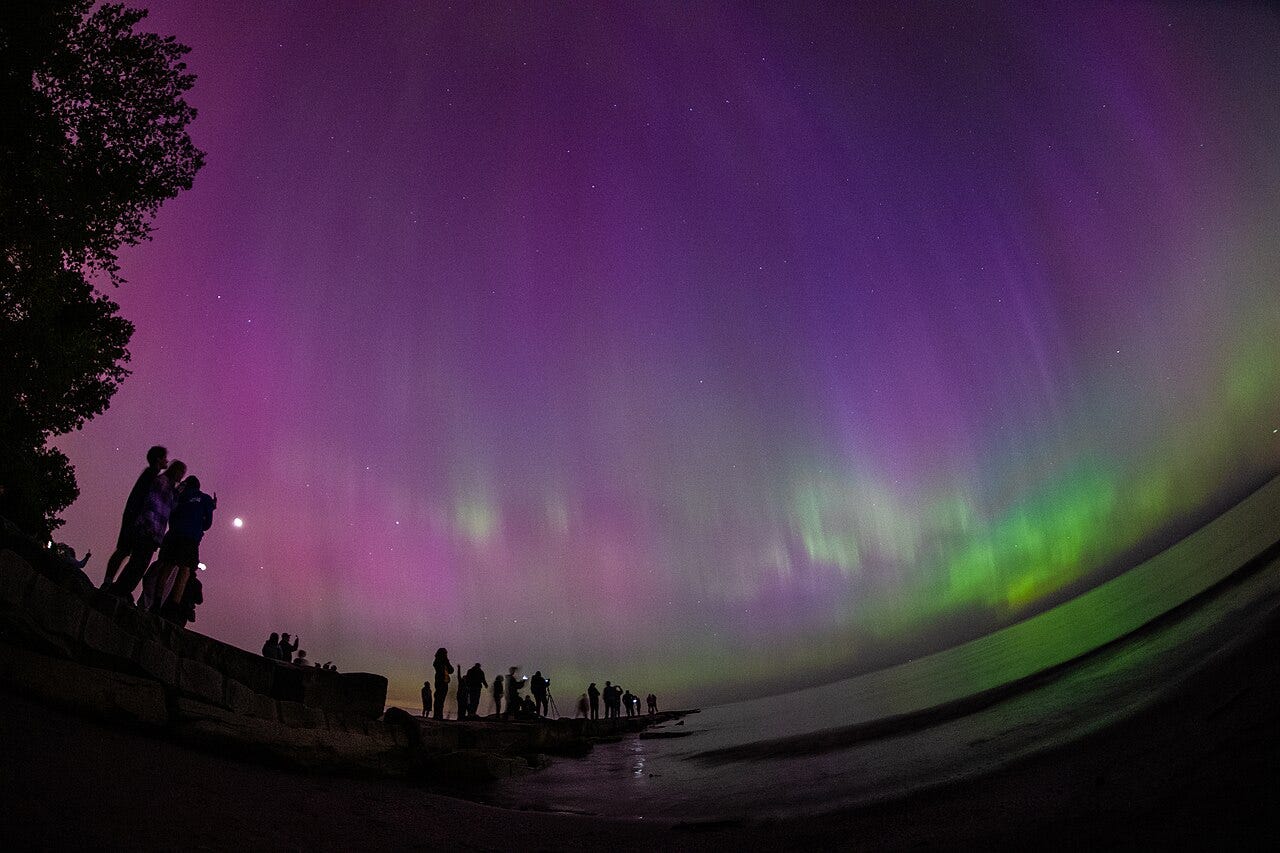The essential practice of well-being

An extreme solar storm gave people around the planet a rare experience of the Northern and Southern lights. Out of the dozens of photos from last night already posted to Wikimedia Commons, I selected this one taken by Erik Drost because it spoke to me of the shared experience of awe in witnessing this event.
Dacher Keltner is the co-founder of the Greater Good Science Center and author of the book, Awe: The New Science of Everyday Wonder and How It Can Transform Your Life. According to Keltner and the team at GGSC, awe is one of the essential building blocks of individual and community well-being—”the behaviors that research suggests will support your health and happiness, and foster positive connections with other people.”
The Guardian interviewed 380 top climate scientists about what they felt about the future and published the result this week. Listening to what these scientists had to say pushed me to consider well-being in the light of the ongoing and deepening climate emergency. I know from my own work with the Center for Healthy Minds that well-being is not something that just happens to us. It is a skill. And as parents, caregivers, therapists, educators, it is a skill we all need to be learning more about and practicing today.
Here’s Richard Davidson, neuroscientist and founder of the Center for Healthy Minds at the University of Wisconsin, Madison, talking about the skill of well-being at the Greater Good Science Center’s Mindfulness & Well-Being at Work conference.
Based on our research, well-being has four constituents that have each received serious scientific attention. Each of these four is rooted in neural circuits, and each of these neural circuits exhibits plasticity—so we know that if we exercise these circuits, they will strengthen. Practicing these four skills can provide the substrate for enduring change, which can help to promote higher levels of well-being in our lives.
The four constituents he describes are: resilience, outlook, attention, and generosity. He describes each of them here. Take the time to read this short summary on the Greater Good Science Center website.
From The Interconnect Archives
Subtle Reminders of Connectedness—Applying the neuroscience of compassion, kindness, and awe. This post includes an overview of the Greater Good Toolkit for Kids—“science-based practices to nurture well-being in young minds.”
Elsewhere on Substack
And speaking of Attention, one of the four constituents of well-being…
Anya Kamenetz writes The Golden Hour: climate, children, mental health.
I especially appreciated her post On Noticing What’s Good—Shining your attention where it belongs.
I learned about the Climate Mental Health Network from Anya in this post. You’ll find their excellent resource How to Talk to Young People About Climate Emotions here. They offer a version for talking with elementary age young people, and a version for middle and high school age youth (downloadable, in English or Spanish). In addition, they offer a link to a webinar on the topic. Thank you, Anya.
Courtney Marten writes the examined family.
I recommend her post Another word for love. It is an interview with Carvell Wallace about his new memoir. I’m reading it now. Thank you, Courtney.
Elsewhere on the web
I watched Butterfly in the Sky—a documentary about Reading Rainbow, the children’s television series, and its host, LeVar Burton, that ran on PBS for 26 years.
“Reading Rainbow was not about learning to read. It was about loving to read.”
Ed Wiseman, Reading Rainbow director
This is a beautiful and important documentary that covers Reading Rainbow from conception in 1980 to the loss of funding during an era when PBS and their children’s programming became a political target. I found the documentary extremely relevant today, as we consider children and the ever changing media environment. LeVar Burton is in the host seat, narrating much of the story, along with other key people involved in the show. The producers include a series of interviews with the “Book Review Kids” who are now adults with clips from their book reviews when they were children. The short segment about how they created the Reading Rainbow theme song is awesome, especially if you are familiar with the theme song.
[Note: The documentary is aimed at adults but I think some older kids would enjoy it. It takes you behind the scenes on several locations, including a dramatic lava fountain during an eruption of Kilauea. Oh, beware the bat cave.]
The original Reading Rainbow series is available here on YouTube.
Be well. Thank you for making time to read The Interconnect. I’m glad you’ve found your way here and I hope you stay a while. And please consider sharing this post with family, friends, teachers, and/or colleagues who might appreciate it and put it to work.


